|
In late 2015 we decided that we were just getting too old to deal with our Jayco Swan Outback so we decided to sell it
and look for a replacement that would make life a lot easier.
The result was a 1988 Toyota Coaster motorhome that had been converted in 2012. The age of the vehicle is a bit frightening BUT it was in such good condition and
the interior was so nice, that we just couldn't pass it up.
The price, at $24,000 was also quite attractive so we decided to 'throw caution to the wind' and went ahead and bought it. This page will be all about the Coaster,
the changes we make and the various trials and tribulations we encounter along the way.
A look around
Before I launch into the changes we have started to make and the additions to the setup, here is a look around the vehicle more-or-less as we purchased it.

The front end and right hand side.
On the roof there are 3 x 90w solar panels, a rack for a kayak and an Air Command ibis 3 air conditioner (more on the air-conditioner later).
Other external features are a roo bar, high gain phone antenna, roll-out awning, side ladder, pole carrier, fishing rod holder and a tow ball.
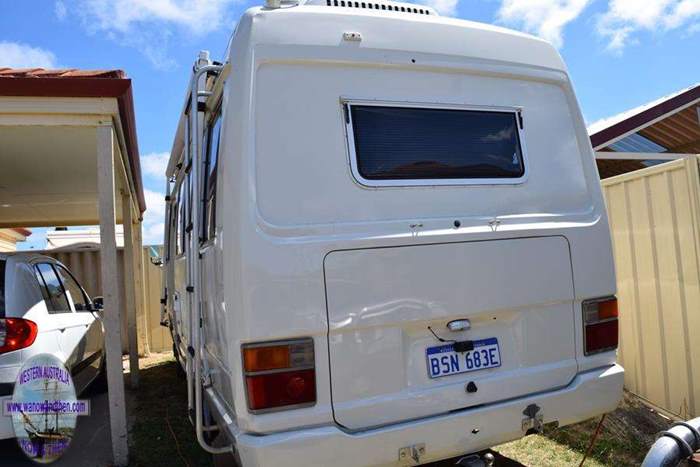
The rear end

Left hand side

The boot
The boot space isn't exactly huge but it is connected to all the under seating space at the rear of the vehicle so there is enough room
to store the annexe walls and floor as well as a BBQ and a few assorted bits and pieces.
We had some initial problems with dust getting into the boot and from there getting in to the rest of the vehicle. We have tried to sort this
out by putting an extra rubber strip around the inside of the boot cover (see above). This did help a bit but it hasn't solved the problem entirely
so I will get some more rubber strips and see if I can finally get things dust free. For anyone who is interested we got the self adhesive rubbers
strips from EBay.
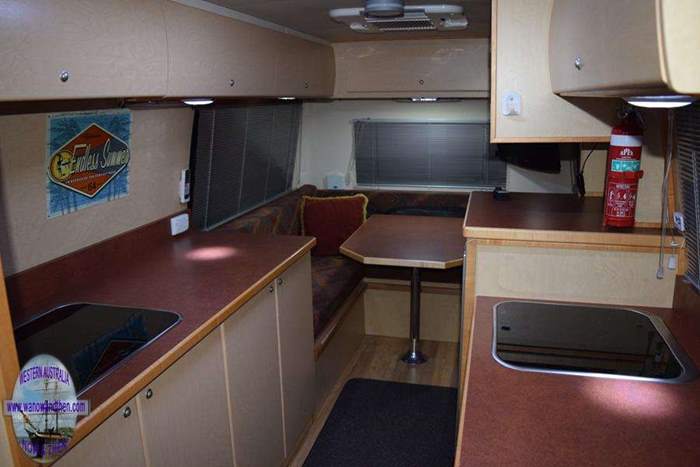
From the entry door looking back
Internal features include, Smev 3 burner cook-top, Sink with an on-demand pump, 12v range hood, Waeco 110 12 volt fridge, Microwave
(that we have now removed), lots of LED lights, Fiama roof vents in the main area and toilet / shower and a lot of cupboard space.
There are two water tanks, one 9kg gas bottle box, a gas water heater with 22 litre holding tank and a zip up holder underneath to hold all the hoses.
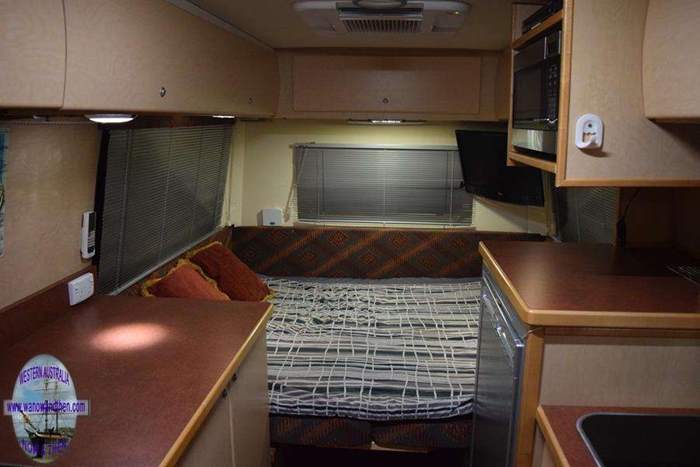
How the bed makes up
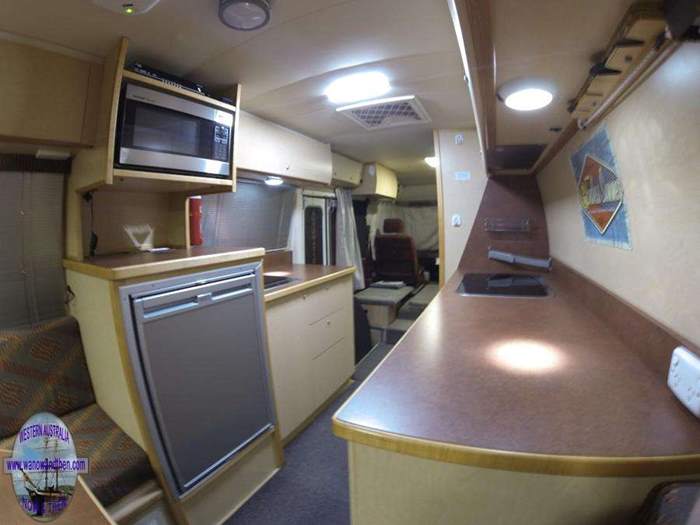
From the rear looking forward

Driver's seat
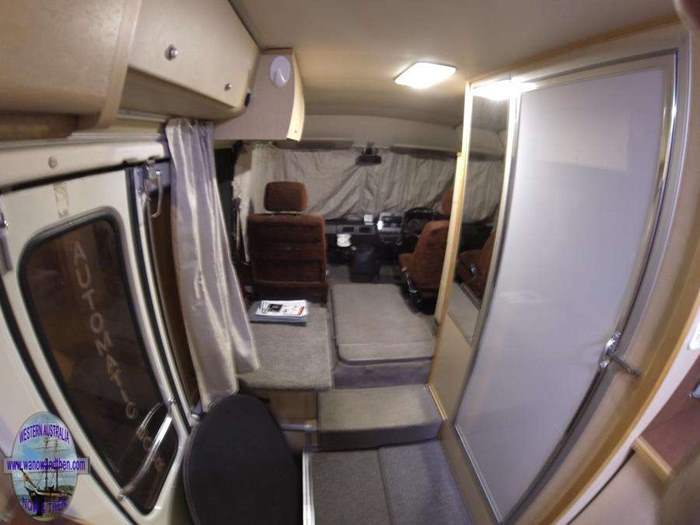
Toilet / Shower and front cab area

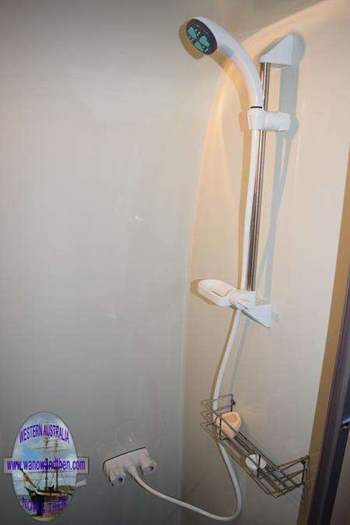
Toilet / Shower
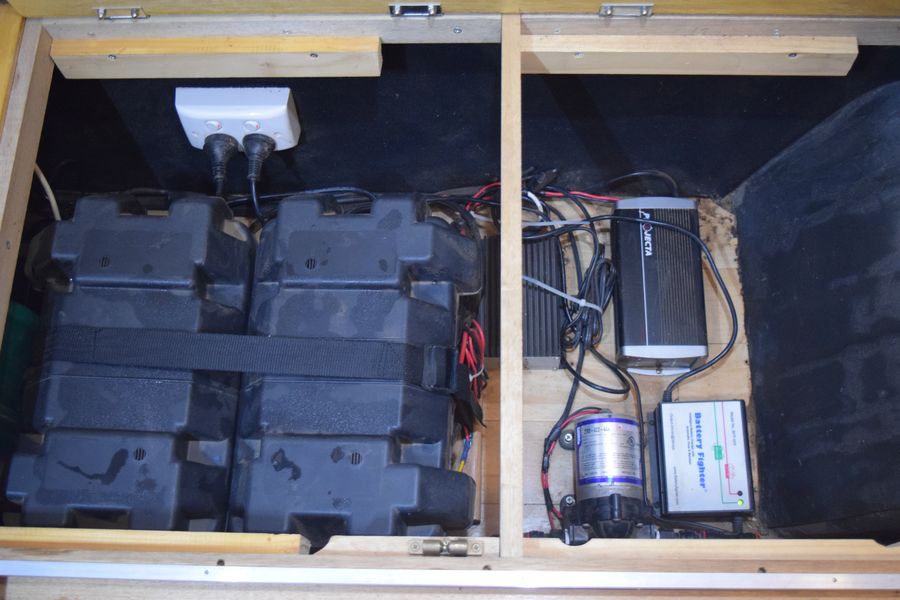
Electronics Bay 1
The observant may notice that there is something undesirable here. The water pump has been mounted inside the vehicle right next to
two 240 battery chargers and a 24 to 12 volt charger. Not the best idea.
Moving the pump would be just too big a job so I have now moved the battery chargers away from the pump as far as I can.

Electronics Bay 2
Up in a roof top cupboard are the main controls for the electrical system.
The gauge on the far left gives a voltage reading for the batteries plus an amp reading for any appliances being used. Under that is the fuse box.
Next to that is the water pump switch then comes the solar regulator, 240v safety switch and on the bottom of the shelf a small inverter used to
run the TV.
The Changes
Even though the Coaster was very well thought out and we loved the interior design, there were still some changes we wanted to make.
Nothing too drastic but we have different needs to the previous owners who spent most of their travels in caravan parks. We like to free camp
as much as we can and if we can't do that our next choice is campsites in national parks etc.
To do this without hassles we need a lot more power than someone who relies on mains power most of the time.
The first problem we ran into was the air-conditioner. Despite extensive research and finding some people who are able to run an Ibis 3 on a
Honda EU20i generator, ours simply didn't work.
In order to sort that out we had to buy a 3kva generator and since we have always used Hondas and have been very happy with them, we stuck
with that brand.
There are times when an air-conditioner is simply over-kill and in all our other rigs we have used Caframo cabin fans. We pull them out and move
them to a new rig each time we change so we still have the same fans we bought years ago.
Installation job number 1 was to get those fans into the Coaster. Due to the clever design, where all wiring is either run along the tops of cupboards
or underneath easily removable boards in the bottom of the cupboards, it didn't take long to fit the three fans we already owned. We have always purchased
these fans online from Outback Marine and they are around $100 each by the time delivery fees are included.
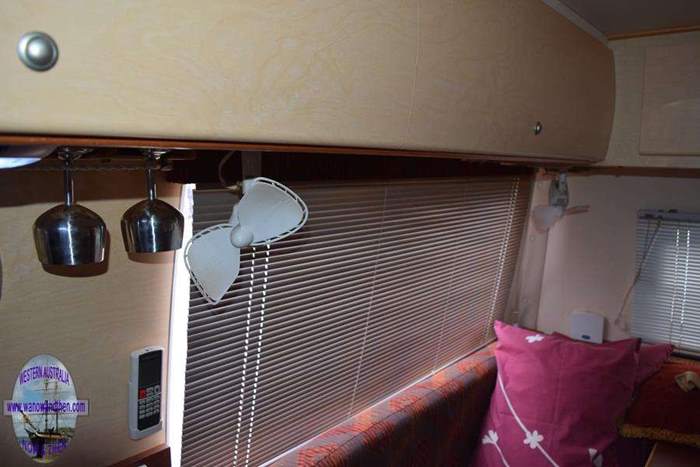
Caframo cabin fans
Job number two was to get a reversing camera. We got ours from Jaycar and because we want to tow a trailer we went with a model that
could use two different cameras. That way there is one camera on the back of the trailer, and one on the back of the Coaster for those times we aren't
towing.
The model we picked has a 7 inch screen and the cameras are wireless so installation was very simple. The Coaster based camera is wired into the
main lights so all I have to do is put the side-lights on to activate it. The trailer has its own battery system so the camera on that plugs into a
cigarette lighter adapter and can be removed when it is not needed.

Reversing camera screen

Reversing camera on the trailer
I am actually getting a bit ahead of myself by putting the trailer picture up at this stage because when we first got the Coaster we had a trailer
but not the one in the picture above.
We had a little Erde trailer that we hoped would turn out to be big enough but just three nights away convinced us very quickly that it was far
too small.

Erde Trailer
After a bit of searching we found what we were looking for on Gumtree (don't you just love that site?) and got a custom made
lock-up trailer that, although it is in need of a good paint-job, suits our needs very well.
It has plenty of room inside and came with a few bits and pieces that we found very useful.

Lock-up Trailer
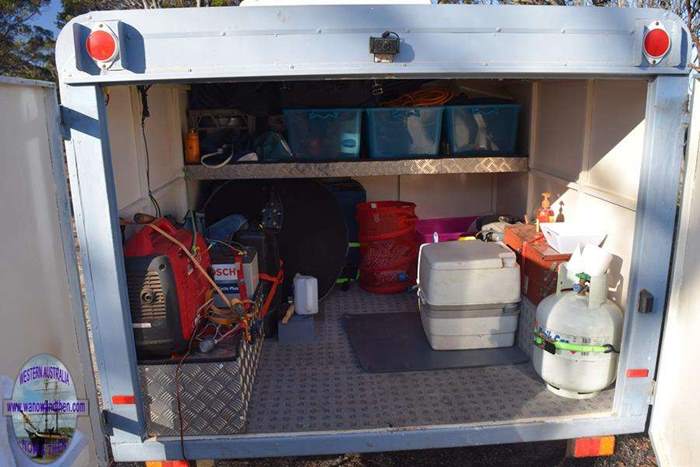
Inside the trailer
Now we have somewhere to store all the camping gear that we don't want cluttering up the inside of the Coaster and
we have even removed the Rhino rack bars and roller from the 4x4 and put them on top of the trailer so we can take
the dinghy with us if we want to do a bit of fishing.
Some people may be asking, "Why the second porta potty when there is one inside the Coaster?". Well the toilet/shower
in the Coaster is great when it comes to showering but it is positively claustrophobic when it comes to using the toilet. I am not
exactly what you might call thin so the trailer is a very handy 'outside' dunny and comes complete with a strip-light for
night time use.
Our plans are to add a solar panel or two to the top of the trailer but for now we have installed a (hopefully) rain proof
box on the front of the trailer and another underneath the Coaster so when we are stationery a wire can be pluged in to connect the trailer
battery to the house batteries.
If you are looking for low voltage T plugs, the cheapest we have found in Australia come from Caravans Plus.
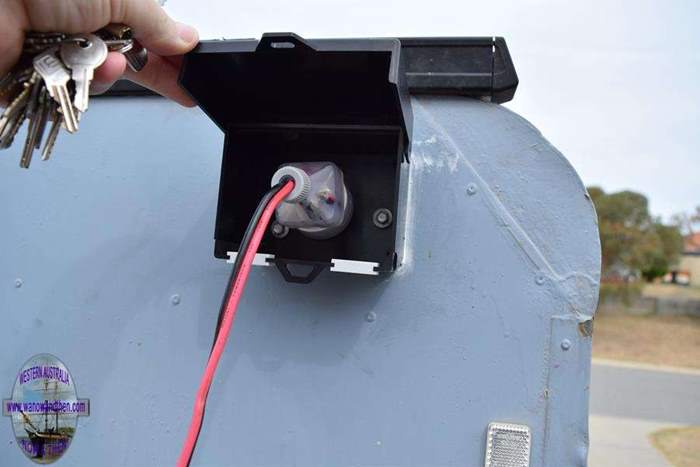
Low voltage plug box
Other changes and additions so far include a dash camera that is not only useful for recording road incidents, it is also great for adding a
bit of footage to our videos. The Coaster is a great platform for a
front facing camera as there is no bonnet to get in the way.
Although we don't use it much, we have also installed a 1000w pure sine wave inverter that we had used in the Jayco from time to time.
This one is quite useful as it has a remote on/off switch, so I don't have to go ferreting around in the boot each time I want to turn it on.
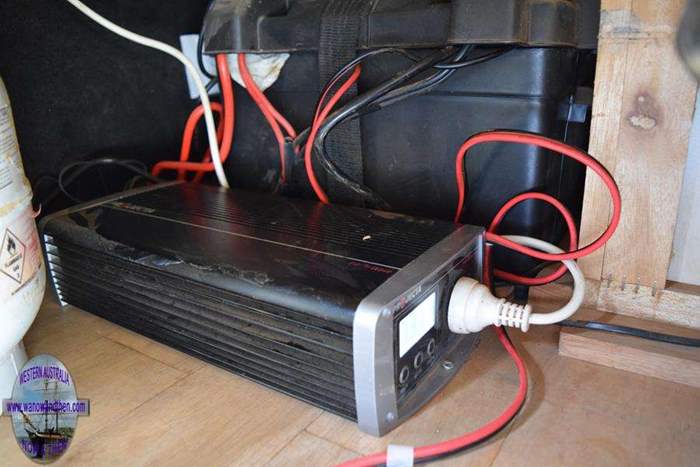
1000w sine wave inverter in the boot
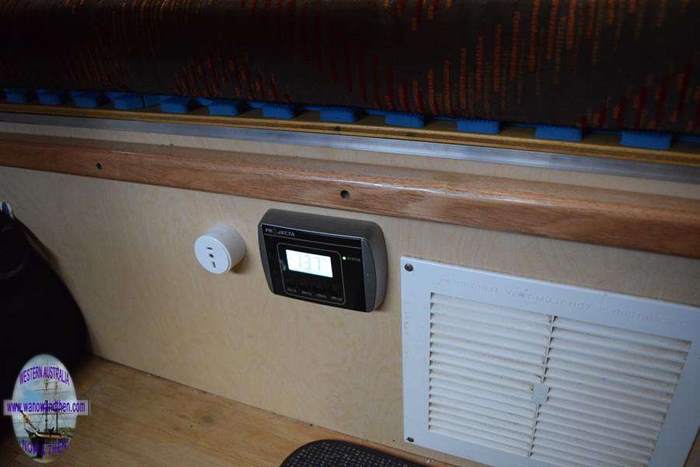
Remote inverter on/off switch
The Coaster didn't come with any flyscreens so we wanted to find some way of putting a screen on without spoiling the look of the vehicle.
In any case the two rear windows can only open a few inches so it wasn't worth getting big security screens installed.
We came up with a home-made flyscreen using push button clips and magnetic strips. It isn't exactly perfect but it does do the job and when
we get round to making the next one, we will have learned from the mistakes we made with this one.
The basic method to make the screen was to fold over pockets on each edge, sew them down with a sewing machine, insert the magnetic strips
and then sew all the openings shut.
We were lucky that there were already metal press-studs on the vehicle so all we had to do was put them on the screens and clip it together.
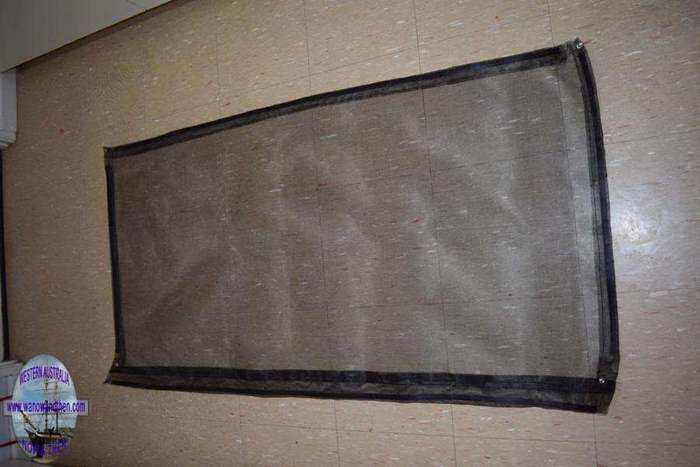
Home-made flyscreen
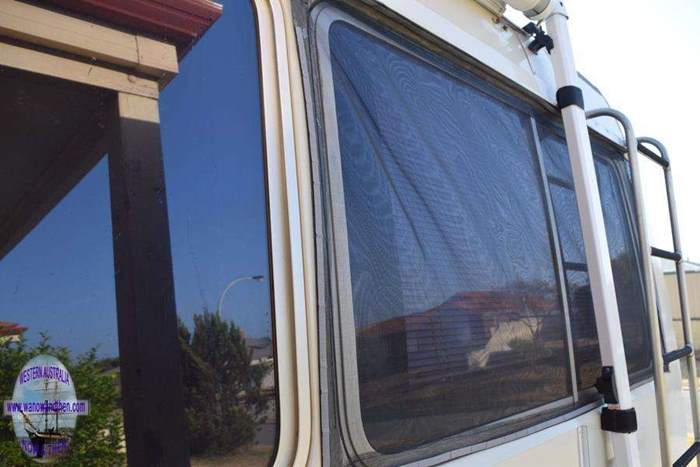
Home-made flyscreen in place
The inside of the vehicle is in such good condition that we don't want utensils etc. to start scratching
up the interior surfaces of the cupboards.
In order to protect the cupboards we have installed non-slip matting and also found plastic containers
that fit each cupboard as fully as possible.
There were some containers in the Coaster when we bought it but we have added them to all cupboards
where items like pots and pans and cutlery and cooking implements are kept.
We were also lucky enough to find a wire spice rack that exactly fits one of the cupboard doors.

Containers for cupboards

Problems and lessons
The first real trouble we had with the Coaster was when we were touring the wheatbelt. As we pulled out of a rest area in a small town
the clutch gave up and we were stranded.
Thankfully we had RAC roadside assistance top cover so a tow was organised and we were taken over 100km to the nearest town with a workshop
able to sort things out.
The job was sorted out quickly BUT we were thinking about what future problems we might have and decided to 'bite the bullet' and have all the lubricants
changed, sort out any obvious problems and get the bearings done. By the time everything was completed we didn't get much change out of $2k but
it was all work we knew we would have to do sooner or later anyway.

A sad sight.
On the next trip it was the trailer that decided to give us trouble when a wheel collapsed and the hub, plus rim was more or less torn to pieces.
Of course this happened in another remote area and we decided to get all the running gear, axle, hubs, rims, tyres etc. replaced. About $1200
later the trailer is now sorted out and we are hoping that we have done enough to prevent any other trouble for a while.
The lesson we have learned from this is to get ALL the maintenance done at the same time, even if the budget doesn't allow for it. If something
goes wrong on the road, then it will end up costing a lot more to sort things out.
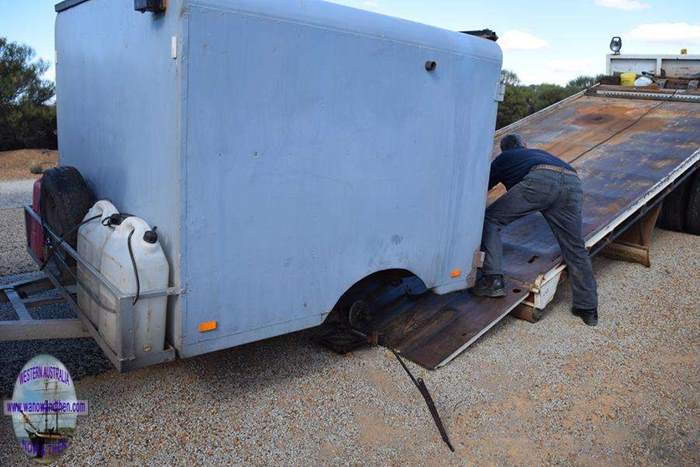
Another sad sight.
One rather expensive item we decided to add to the gear we cart around was a Weber Baby-Q. The previous owner told us about them
and he had even cut a special section out in the boot so one would fit so, ignoring the ridiculously high price, we purchased one.
It does a great job cooking steaks and the usual BBQ fare but we are yet to try and do a roast in it. To be honest, I think they are vastly over-priced
as we were able to buy a big stainless steel home BBQ with a rotiserie for less than we paid for the Weber.
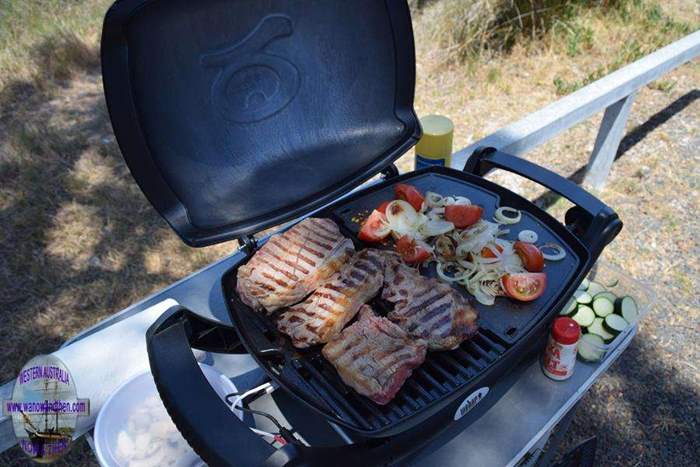
Weber Baby-Q
As the Coaster is the only motorised vehicle we travel with and it isn't possible to move once everything is set up for a few days,
We decided that having another way to get around was needed and the first thought was an ordinary bicycle. As we are getting on a bit
and have all sorts of joint problems, we started looking into E-Bikes. After a few weeks of research we decided to buy a
Leitner folding E-Bike.
Although we have only used it on a couple of trips so far, it is obvious that it will be a very useful addition to our 'travelling circus'. Having
a secondary mode of transport that has a range of around 30km on the battery (in pedal assist mode) means we have a little more
security in more remote areas.
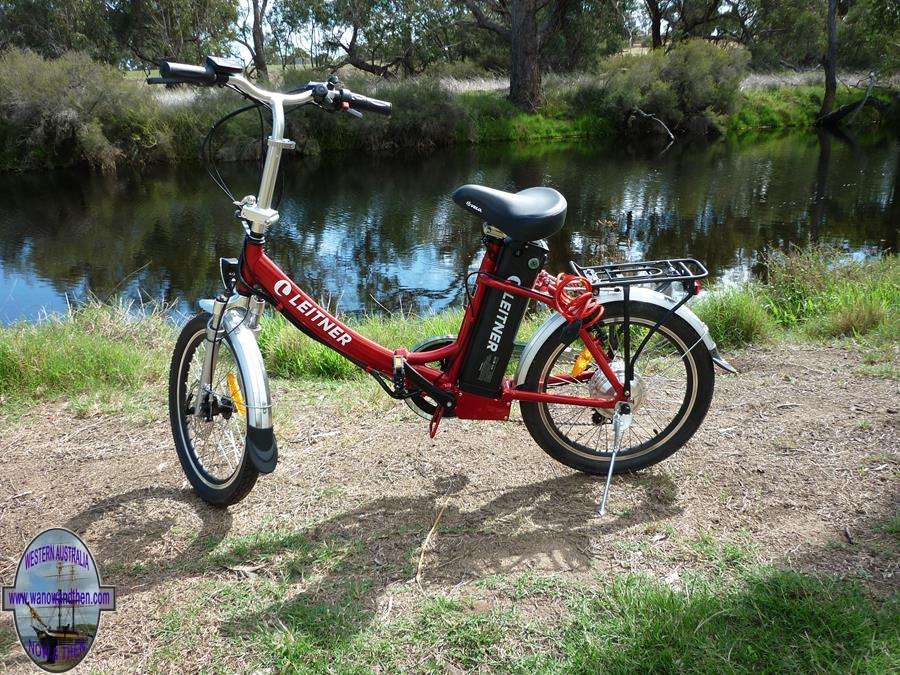
E-Bike
So far we only have one folding bike but we need to carry two bikes so we can both go exploring away from the Coaster when the annexe is up.
The only solution to this was to put a bike rack on the rear of the Coaster and as we need to tow a trailer, it had to be a rack designed
to allow towing.
The result was this rack that is very strong and is very easy to remove without having to take the tow ball off. An essential requirement to
allow us to quckly access items in the boot.

Bike rack
There are some occasions when one of us wants to laze in bed a bit longer and one wants to get up and use the computer. This was a bit difficult
as the seating and table area in the Coaster is also the bed area.
I had thought of all sorts of ways of building a swinging arm table at the front of the bus but eventually it all came to nothing.
A $5 folding table from an Op Shop solved the problem as it fitted perfectly in front of the passenger seat. It
gives just enough room to set the laptop up and still sit comfortably.

Front work area
Our little trailer keeps on getting more and more modifications and the latest one allows us to connect a 240 v power lead to the generator without going through the
back doors.
The outlet had to be weather-proof with a cover big enough to hold the cables up out of the rain. Another visit to the Op-shops and I was lucky enough
to find a power point and a cover that was intended to be a toilet roll holder. The edges were all sealed up with silicone and wire protected by using a
cable shield and held firmly in place with more silicone.
The trailer needs one more modification to allow us to use the generator with the doors closed and that is some sort of vent that will allow oxygen to
get in but will also keep dust out.

Trailer power outlet
The next project was to put a folding shelf into the trailer so that we have a quick and easy way to put things up without having to get the camping table out.
It will also be used if we want to do some outdoor cooking as the camp stove will sit on the shelf. I looked at the commercial shelves for fitting to the outside
of caravans and the cheapest I could find was $145. I was pretty sure I could make one cheaper than that.
All up the cost was just over $70 and I found everything I wanted at Bunnings. Hunting around salvage yards would drop the cost even further but I just
wanted to get the job done.
At first I wasn't sure what to use as the shelf but there was a special on the cheap shed 4 shelf shelving units. Individually the shelves are a bit flimsy - even though
the packing says each one will hold 50kg. In order to make them stronger I simply slid one shelf into another and used the bolts that come with the unit to
attach them firmly.
The other items to build the shelf were, 35kg rated chain, 4 x 110kg rated quick chain links - overkill but they were the smallest I could find, 4 x wire eye straps,
610mm continuous hinge, hasp and staple, a small padlock and a packet of rivets.
I had originally thought about building the shelf on the outside of the trailer but it fitted well inside the back door and the door is designed so that it will
swing round and sit flat against the side of the trailer so I decided to have the best of both worlds.
I decided not to cut the chain as the unused portion can be hung down under the shelf and used to hold cooking utensils, cloths etc.
Normally I am a pretty useless handyman but this project went well and everything was done in about 2 hours.
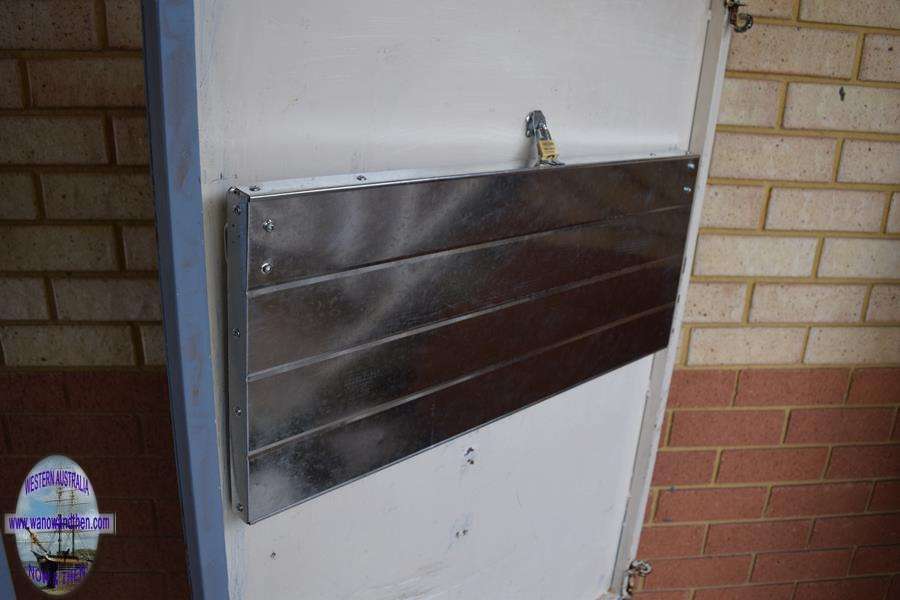

Trailer shelf
Expensive Inattention
We set off on a big trip from Perth to Broome and things went well until we were past Port Hedland.
After stopping for lunch at De Grey River, we pushed on to Pardoo where we were due to turn north and reach the first
of what were supposed to be our longer term campsites of the trip at
Cape Keraudren.
Alas it was not to be. As we pulled in at Pardoo roadhouse there was a strange noise coming from the engine bay. One look at the
temperature gauge told me that there was some kind of coolant problem.
We let the engine cool down and then re-filled with water to try and find the leak. Nothing doing but as the engine started up again there
was a nasty knocking sound that certainly wasn't there before.
The vehicle was still drivable so we booked in to the Pardoo Roadhouse caravan park for the night.
The following day a tow truck arrived from Port Hedland and once again we were at the mercy of the local repairers. An initial examination failed to determine
what the problem was and we didn't want to be stranded in Hedland for weeks or even months so we had to ship the rig home.
Finally we managed to get on to Bains Transport who had a truck coming through from Broome. By 8pm on Wednesday night
the Coaster was loaded and we went to Cooke Point caravan park where the RAC had booked a cabin for us to stay in
until we could get a flight home.
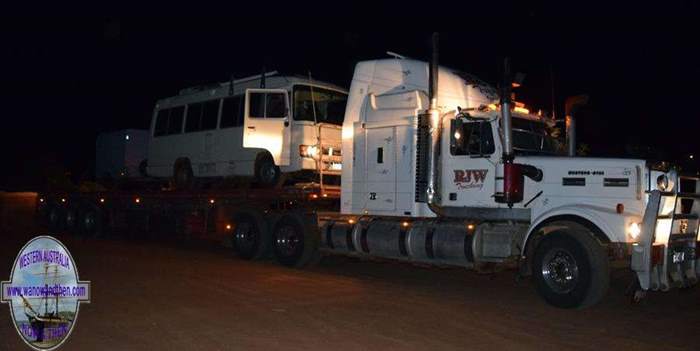
Sending the Coaster to Perth
Once back in Perth it took 2 months to get the Coaster repaired which, among other things, involved a complete engine rebuild.
The cost, including towing, transport, flights and mechanical work, $12,433.00! Our $24,000 Coaster now owed us a whole lot more.
In the interim I re-painted the trailer so that it more closely matches the Coaster's colour.
When we got the Coaster back we did a couple more trips and found there was a problem developing starting the engine. Sometimes
it would be fine but others we would get a 'click, click, click' before the engine would turn over.
We tossed up whether we should take it in to a mechanic to get it checked but in the end it did keep starting and we didn't want to lose
time sitting in a repair yard for half of a trip.
Once we got home we replaced the starter motor and the starting problem was solved.
Other work we have had done in the past two or three years includes a radiator re-core and a replacement muffler. It wasn't possible to get a new radiator
as they aren't available any more and the same applied to the muffler so there was some work done to the exhaust system to make a different type
of muffler fit.
Owning an older Coaster isn't a cheap or easy experience. There is some rust around the body and every year I spend time digging out any new patches,
spraying fish oil everywhere I can reach and then bogging the hole back up.
We have just put yet another set of starter batteris in (our second set since buying the vehicle) and there is some sort of an exhaust leak in the engine
that is going to need attention soon too.
If you take on an old vehicle like this, you need to be dedicated to it both emotionally and financially.
We are going to keep this vehicle going as long as we possiblty can and at some stage I will dig out all the receipts and put up a complete list
of everything we have spent on it so far. I fully expexct the figure to be well over $50k.

Re-built engine
We had yet another breakdown on the very last day of a trip when we had almost reached home.
There was an odd noise from underneath and the steering started to feel odd. This turned out to be due to a ball joint failure so it was another
call out for the RAC and another trip to our local repairer.
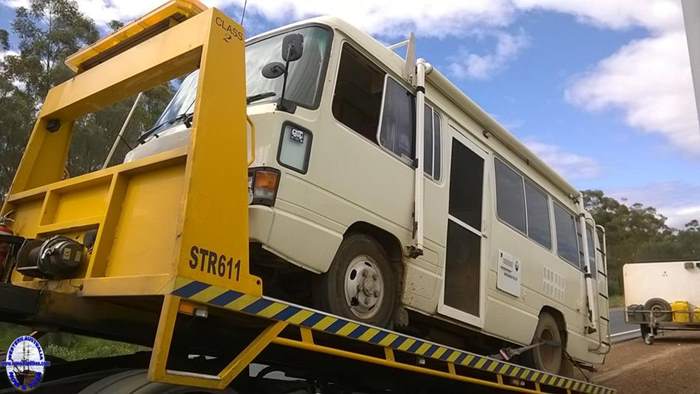
Another break down just before we got home.
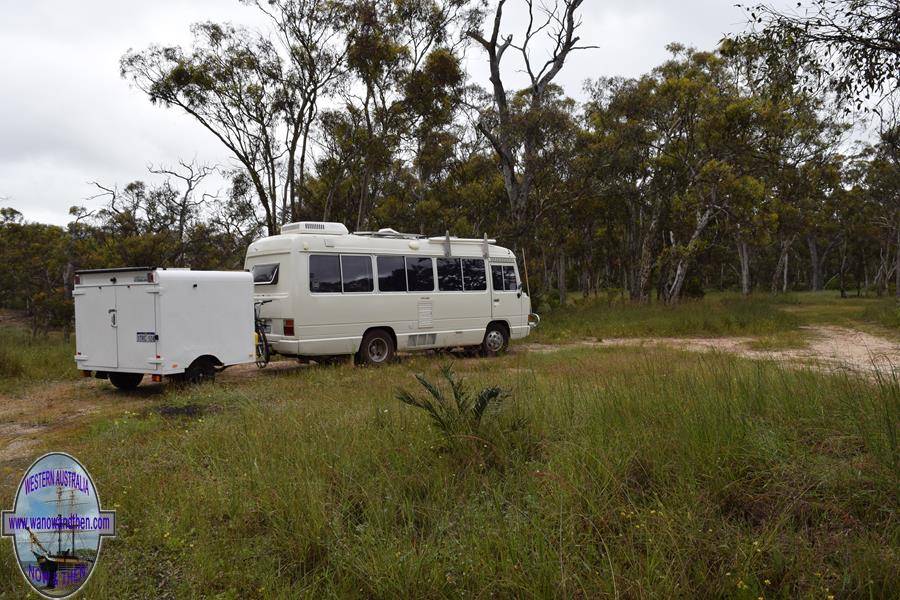
The re-painted trailer.
The Coaster and a Dinghy
We had never tried going away with our Coaster and our dinghy at the same time. We wanted to test this combination to see if it would work, so after modifying the trailer
by installing a boat rack and some extra tie-down points we wanted to find a nice location where we could hand launch the boat as we didn't want to move the Coaster
every time we used the boat.
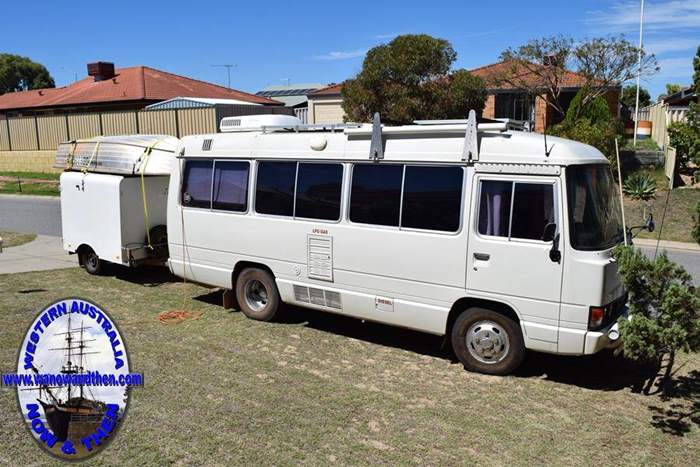
Coaster and Dinghy combination
In order to hand launch the dinghy we bought a small boat-dolly that uses a standard tow-ball connection to attach to the boat trailer. The boat trailer is a
Mangrove Jack collapsible trailer and is both light and very strong. (This is by far the best portable boat trailer
we have ever owned.)

Boat dolly and Mangrove Jack trailer
Although this combination was successful and the trip was largely a success, the main drawback is that we cannot take all the gear we need to camp out in the bush
as we would exceed the weight limit of the trailer.
If we ever have to take the boat and bush camp, we will have to take the 4x4 with the boat on its main trailer as well as the Coaster.
A Portable Pump
I have seen a number of commercially made portable pumps mounted in cases but the price was always ridiculous so I decided to put one together myself.
It was easy enough to do and only involved getting an on-demand pump, a safety case, a length of hose pipe, 3 low voltage plugs, some wire and a few nuts and bolts.
The pump was mounted directly on to the base inside the safety case and then I drilled a hole in the back of the case for the electrical wire to go through.
I mounted a female T plug on the back of the case and made a male - male T plug cable to connect to any of the T plugs mounted on the trailer or Coaster.
The whole job took only a few minutes and now we have a very simple to use water pump that we can take anywhere. The only change I may make at some stage is to
add an on/off switch to the case, as at present I just remove the T plug from the power to stop the pump.
It also acts as a handy back-up pump if the internal pump on the Coaster gives up.
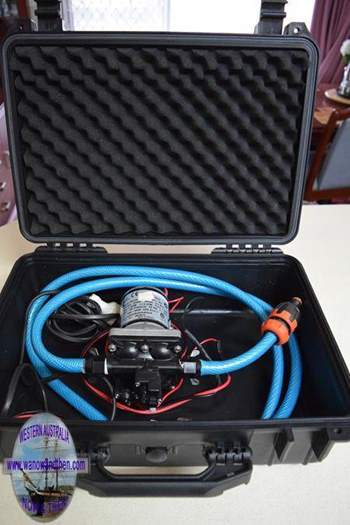
Portable pump
For anyone who might be interested, I put together a video of our Coaster some time ago but then forgot to put it up on this page.
Well finally, here it is plus a few other Coaster related videos.
You can see our adventures so far in the Coaster on our blog pages :
Fitzgerald River and back |
Southern Wheatbelt |
Northern Wheatbelt |
Toodyay to Moora |
Perth to Broome Part 1 |
Perth to Broome Part 2 |
Third Time Lucky |
East of Esperance - South Coast - Part 1 |
East of Esperance - South Coast - Part 2 |
Coaster and Dinghy - A new combination
|








